Spotted on Instagram. Also: relevant.
( Modified by ? Original artist is Jake Likes Onions. )
I remember the first video my family ever rented. It was a James Bond film, Never Say Never Again. We rented it (on Beta videocassette) from the video rental counter that popped up in our local five and dime, a place that was called Gibsons, in Grafton, Virginia. That was sometime in 1984. I’ve rented hundreds of videotapes and DVDs over the years from many different shops ranging from tiny mom & pops establishments to Blockbuster. But the rental store I enjoyed most was a family-run place called Family Video & Computer Center at the Hilton Shopping Center in Newport News, Virginia. What made that place special to me was that, in addition to movies, they also rented computer software.
What got me thinking about FVCC (no connection to the “Family Video” rental chain found in the Midwest and Canada today) was a recent episode of the Retronauts podcast I listened to, with video and game rental stores as the topic. The show talks about game console rentals — cartridges and CDs/DVDs. Now, while I did rent the odd PS2 title here and there in the early ’00s, I didn’t do it often. What was unique about FVCC is that they rented games and apps for computers. I’m talking about magnetic media. They had titles for the Commodore 64, Apple II, Amiga, and DOS / Windows PC.
I don’t remember just how I found out about the place but, just after it opened, I remember going in and renting the game Echelon for the Apple II. I recall that there was a “NO PIRACY” sign on the wall, but the guy working the counter let me know I could get a free rental by providing a new parameter to copy one of their games (one that wasn’t part of Copy II+ or whatever parameter copier you might have used). Good times.
The way it worked was — as I recall — you were technically buying the software, with an option to return it for retail price minus $5 within five days, or something along those lines. There were/are laws against renting computer software in the United States and things were setup in a way that got around them.
As often happens, I got an idea for a blog post about a place of my past that readers may find interesting, and jumped online to scour the search engines for some tidbit of history I could use to prop up the piece. And, as often is the case, I found nothing. Memories that make for an interesting post on this particular blog, by their very nature, often concern places and events that happened pre-internet. There’s all too often just not a trace out there about the topic in question.
In this most recent search, I was using keywords that would target the local newspaper where I grew up. I wasn’t having any luck, when I stumbled across a newspaper index / archive site that seemed to offer possibilities for my search, for a monthly fee. So, I went in on it and almost instantly found a full-page article concerning the place I had in mind. Stunned, I quickly searched for a number of other ideas I’ve had for both this blog and my other, Nostalgic Virginian, that were search engine dead ends. Boom — relevant material on every count materialized. (There are some nice posts in store, I think!)
Sitting there quite satisfied, it then occurred to me that classified ads over the decades may be part of this archive. I was something of a serial platform monogamist way back when, moving through a great many machines over the years. I would put one up for sale in the local paper and then, when it sold (usually with $ome help from mom and dad), I would jump to the new platform. So, I began searching on my home phone number for the two houses we lived in while I was growing up in the Hampton Roads area of Virginia, and — voila! In no time, I located ten scanned classified ads that, in my youth, I had written up and phoned in to the Daily Press newspaper. It’s amazing for me to sit here today and look at these decades-old artifacts from my computing past. The dates that these ads ran in the paper have adjusted my memory a bit as to what was happening just when, but I do remember it all.
I hope readers find this collection at least an interesting glimpse back, if not so profoundly fascinating as I do.
The subreddit r/Retrobattlestations is one of my favorite vintage computing project outlets on the net. The sub runs frequent competitions, and last week’s compo was High Score Week. During a High Score Week, members pick a game for their favorite vintage platform, score up as best they can (on actual hardware — no emulators allowed), and submit photographic evidence of their pixel pounding badassery. Others join in and rank on the scoreboard and, in the end, winners are regaled with prizes. (I’ve made a habit of festooning a door in the Byte Cellar with mine.)
During this High Score Week, I made thirteen submissions on as many platforms and had a lovely time so doing. As a nice side-effect of my labors I became reacquainted with the old classic from Japan, Silpheed from Game Arts (and brought to the states by Sierra), and am presently somewhat addicted to playing it at length, and on as many platforms as I can.
Head over to my r/Retrobattlestations entries photo gallery for a closer look.
Good times!
Visit a gallery of all my r/Retrobattlestations entry photos. A complete list, with links, of the fun I've had with challenges in that subreddit over the years can be seen below. Good times!
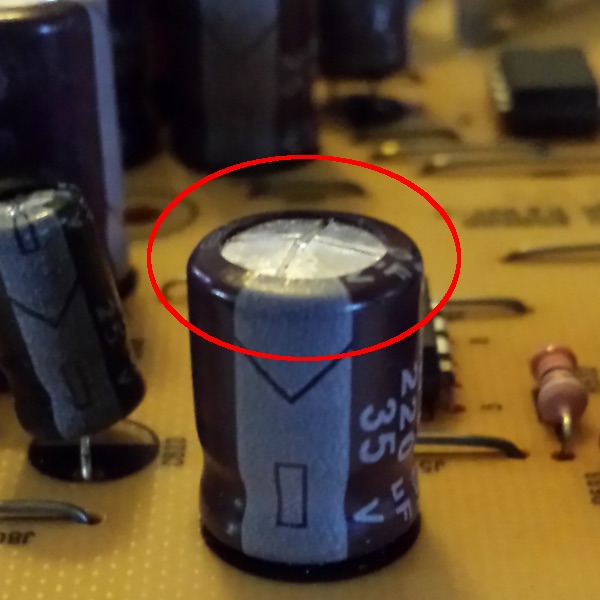 I spend a good deal of time these days on various telnet BBS that are (naturally) focused on vintage computing. As such, much of the discussion being had in the message bases is in the form of help / advice requests posted by people with ailing systems of yore and replies by those offering up helpful suggestions. More and more I’m seeing these responses come in the form of something like this:
I spend a good deal of time these days on various telnet BBS that are (naturally) focused on vintage computing. As such, much of the discussion being had in the message bases is in the form of help / advice requests posted by people with ailing systems of yore and replies by those offering up helpful suggestions. More and more I’m seeing these responses come in the form of something like this:
Ok, so your Amiga 500 powers on but goes to a full yellow screen just seconds after boot? I’d suggest you test the power supply with a voltage meter, re-seat the socketed chips on the motherboard, and, of course, replace all the capacitors.
I began collecting vintage computers in 1999 — 20 years ago. The modern computer I had at that time is now considered to be vintage and collectible. I now have a sizable room full of computer systems, setup and bootable at the flip of a switch. Some of them are nearly 40 years old. In all of that time, I have never — not once, ever — replaced a single capacitor. I have never encountered a blown or even bulged capacitor on any of these fully functional systems. And I use these computers quite frequently.
From Wikipedia’s capacitor page:
A capacitor is a passive two-terminal electronic component that stores electrical energy in an electric field. The effect of a capacitor is known as capacitance.
…
The physical form and construction of practical capacitors vary widely and many capacitor types are in common use. Most capacitors contain at least two electrical conductors often in the form of metallic plates or surfaces separated by a dielectric medium. A conductor may be a foil, thin film, sintered bead of metal, or an electrolyte. The nonconducting dielectric acts to increase the capacitor’s charge capacity. Materials commonly used as dielectrics include glass, ceramic, plastic film, paper, mica, air, and oxide layers. Capacitors are widely used as parts of electrical circuits in many common electrical devices/
An unfortunate thing about capacitors is that every type of capacitor will, at some point, fail. The type and quality of a given capacitor plays heavily into its life span — and some vintage systems used rather poorly constructed capacitors. I have seen many examples online of a system malfunctioning and, in diagnosing, a blown capacitor was found and replaced and the system was healed. I can’t say for sure that I have ever seen an example of a capacitor failure utterly destroying a system.
I would like to continue on as I have always done, using these systems as-is with the plan of replacing capacitors on a given system in the future, as they inevitably fail. But, I would like opinions as to just how risky this is.
I am hoping, with this post, to get feedback in the comments from other vintage computer users users of vintage computers (I almost walked into that one…) regarding the issue of capacitor failure. What experiences have you had? What advice can you offer, here? Those of you who have suffered capacitor failures in such systems, were any of them catastrophic, unrepairable? Please leave a comment, I appreciate any feedback.
Also, the Retro Computing Roundtable podcast (my personal favorite vintage computing podcast out there) saw this post and has made a discussion of capacitor failure the host topic of “Episode 191: Re: Recapping.”
A computer geek all my life, in my youth I was a member of several different local computer users’ groups in the Hampton Roads area of Virginia. In 1983 I joined my first, becoming a member of the Peninsula ’99ers, a group centered around the TI-99/4A (my first computer). After moving to an Apple //c, I joined an Apple II group that may have been called the Peninsula Apple Corps. (memory fails me there). A few platforms later, I became an Atari ST user and joined P.A.C.E., the Peninsula Atari Computer Enthusiasts.
P.A.C.E. was a group originally focused on the Atari 8-bit home computer, but expanded to include the ST when it was launched. The group had a supporting newsletter as well as a BBS. We met once a month, had the occasional picnic and pool party, held raffles, ran shows, and were involved in various other local events. Most of our meetings were held in the computer lab at the Gloria Dei Lutheran school (which I discussed in an earlier post). I joined P.A.C.E. in late 1986 and was a member until I moved to my next platform, a year and a half later. I recently got in contact with another member of the group and he unexpectedly provided me with quite a stroll down memory lane.
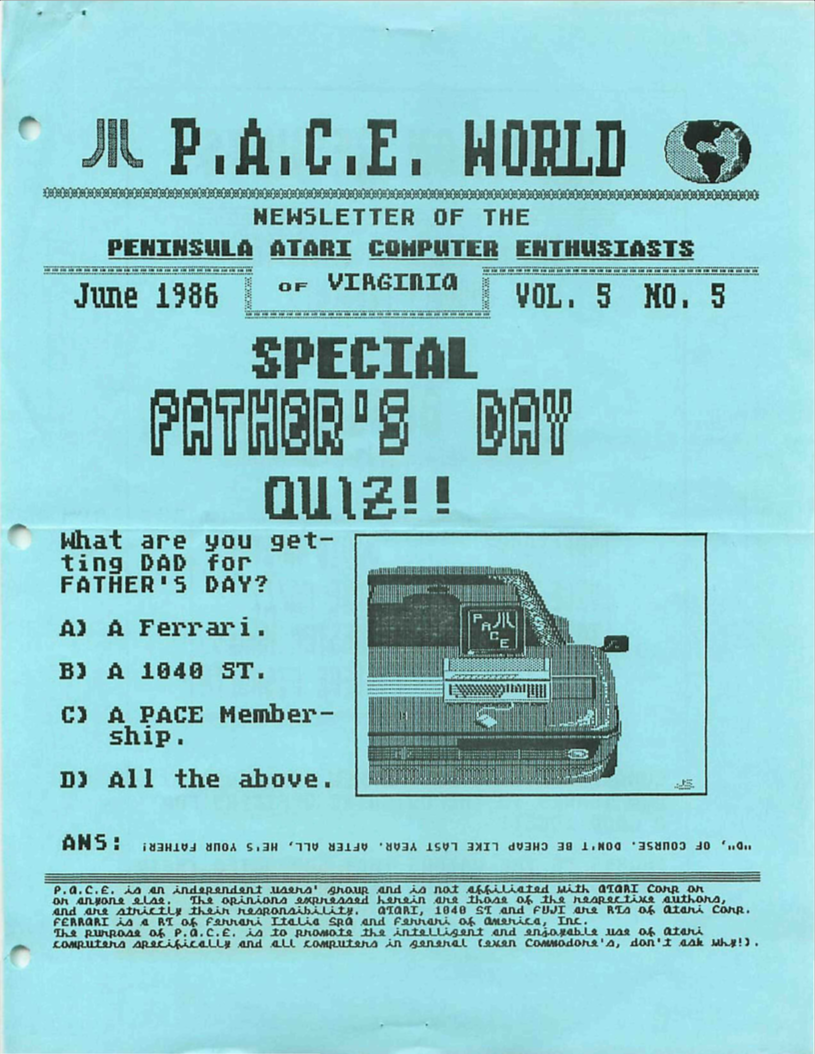 I first encountered Shannon Hendrix online on various local bulletin board systems, and then in person when I joined the group. He was, at one point, VP of the club and was heavily involved in local computer-related events. We were recently chatting about the good ole’ days of P.A.C.E. and the Atari when he told me that he had scanned and preserved a number our group newsletters, P.A.C.E. WORLD. The newsletter was a monthly publication created primarily in The Newsroom on Atari 8-bit computers and put together with both virtual and a bit of real-life cut-and-paste. Shannon was willing to share them with me and I have to say, reading through them was like being in a time machine dialed back to 1986. I remember all of the names, most of the faces, and see that I was even mentioned in one of the issues (June 1987, page 8 [PDF])!
I first encountered Shannon Hendrix online on various local bulletin board systems, and then in person when I joined the group. He was, at one point, VP of the club and was heavily involved in local computer-related events. We were recently chatting about the good ole’ days of P.A.C.E. and the Atari when he told me that he had scanned and preserved a number our group newsletters, P.A.C.E. WORLD. The newsletter was a monthly publication created primarily in The Newsroom on Atari 8-bit computers and put together with both virtual and a bit of real-life cut-and-paste. Shannon was willing to share them with me and I have to say, reading through them was like being in a time machine dialed back to 1986. I remember all of the names, most of the faces, and see that I was even mentioned in one of the issues (June 1987, page 8 [PDF])!
While I can’t imagine anyone else from the group will encounter this post, I wanted to share these newsletters to give readers a glimpse of a little corner of Virginia way back the “home computing” days.
See the full list of PDF scans of the P.A.C.E. WORLD newsletters. (Thanks, Shannon!)
For completeness I will mention that, several more platforms later, I moved to the last users’ group that I ever joined, A.L.F.A., the Amigaoid Life Form Association, a local Commodore Amiga group. (Yes, I was on both sides of the Amiga vs. ST war — and switched sides a few times!) Time spent in connection with all of these groups are some of my best memories, growing up.
I share other details about my users’ group memories in my earlier blog post, “Computer Users Groups of My Past” (2014).
 As those who follow me on any of my social feeds are quite aware, I enjoy the game No Man’s Sky. Actually, that’s something of an understatement. I’ve written quite a few words about the degree to which the boundless universe that Hello Games has given us to explore has captivated me in various blog posts over the past two and a half years. In the first of these, written three weeks after the game launched back in August 2016, I explained,
As those who follow me on any of my social feeds are quite aware, I enjoy the game No Man’s Sky. Actually, that’s something of an understatement. I’ve written quite a few words about the degree to which the boundless universe that Hello Games has given us to explore has captivated me in various blog posts over the past two and a half years. In the first of these, written three weeks after the game launched back in August 2016, I explained,
All my life I have dreamed of exactly this in gaming — an interesting, alternate universe, massive in scale, in which I can freely wander and explore at my own pace. That is what No Man’s Sky is to me, and it’s my observation that many others are similarly moved by the game. The fact that the universe is procedurally generated and that even the game’s creators can’t describe everything that’s out there to be encountered ads to the incredible sense of the unexplored, the alien. There is a lovely feeling of solitude to the whole experience of discovering a world, leaving your mark on it, and moving on to the next.
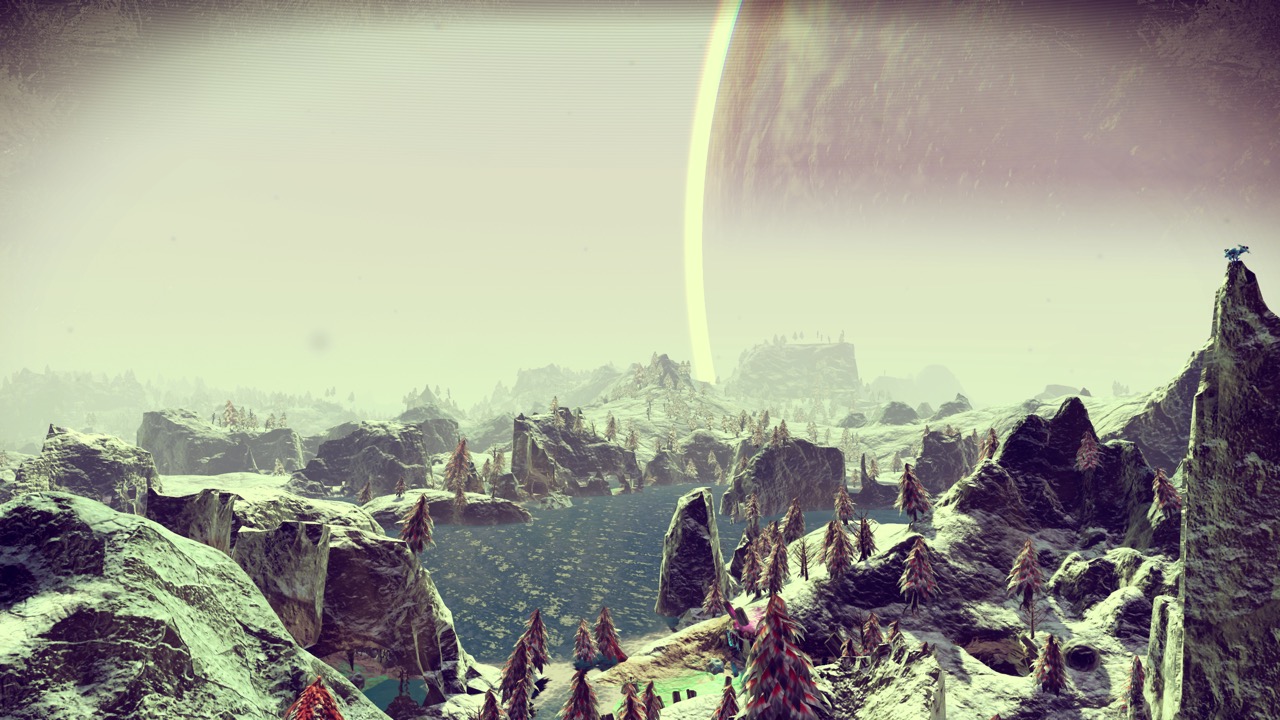 I began playing the game on the PS4 back on its launch day in August 2016. I was so completely drawn into it that just a few weeks later I decided to build a high-end gaming PC — something I hadn’t done in many years — in order to get the best experience possible in the No Man’s Sky universe. The system I built was able to achieve a higher resolution at a higher frametrate than the PS4, as well as allowing mods to be run (which, in the end, I decided to stay away from in the interest of experiencing the gameplay as intended by the developers).
I began playing the game on the PS4 back on its launch day in August 2016. I was so completely drawn into it that just a few weeks later I decided to build a high-end gaming PC — something I hadn’t done in many years — in order to get the best experience possible in the No Man’s Sky universe. The system I built was able to achieve a higher resolution at a higher frametrate than the PS4, as well as allowing mods to be run (which, in the end, I decided to stay away from in the interest of experiencing the gameplay as intended by the developers).
It wasn’t until a week ago, however, that it enabled me not only to travel across the vast and myriad galaxies within the universe at the heart of the game, but to travel back through time within that universe, as well.
Let me explain.
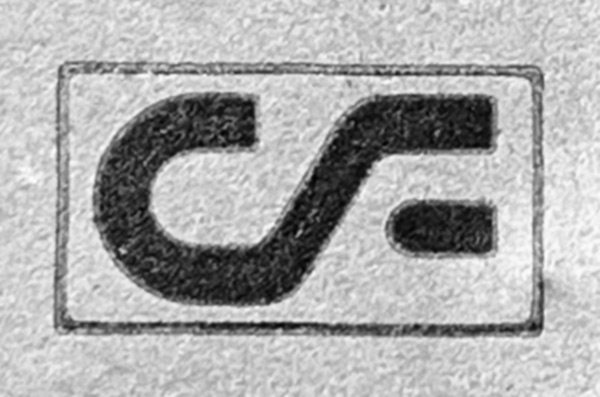 I was recently listening to the latest episode of Retro Computing Roundtable podcast during which there was mention of a 3-inch floppy disk. No, not 3.5-inch, but 3-inch. These disks are known as Compact Floppy Disks (also “CF2”) and were used in a number of systems outside the US, including some models of Amstrad, Tatung, and MSX machines. And, while the Sony-engineered 3.5-inch disks that those of us who don’t think that they are 3D-printed takes on the “save icon” know well are more or less square, these disks are rectangular. This was a curiosity discussed in the podcast at length.
I was recently listening to the latest episode of Retro Computing Roundtable podcast during which there was mention of a 3-inch floppy disk. No, not 3.5-inch, but 3-inch. These disks are known as Compact Floppy Disks (also “CF2”) and were used in a number of systems outside the US, including some models of Amstrad, Tatung, and MSX machines. And, while the Sony-engineered 3.5-inch disks that those of us who don’t think that they are 3D-printed takes on the “save icon” know well are more or less square, these disks are rectangular. This was a curiosity discussed in the podcast at length.
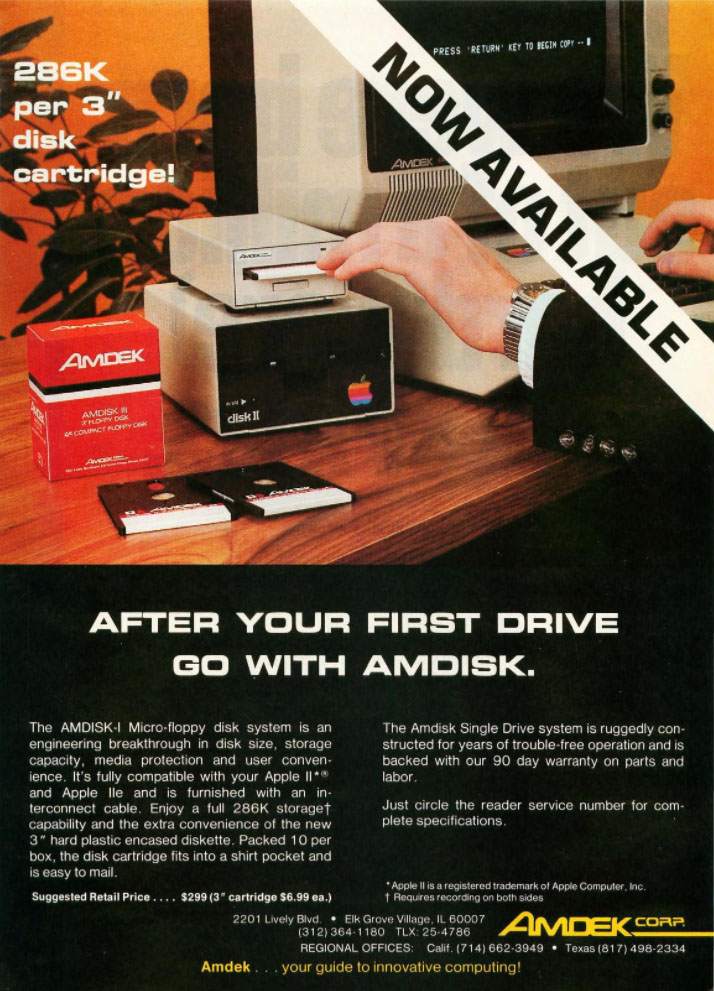 The Compact Floppy Disk form factor was engineered by Matsushita and Maxell and, in the states, it was offered for a variety of machines by Amdek as an standalone unit. The Amdek Amdisk-III was a dual-drive unit released in 1982 at an introductory price of $899, offered for the TRS-80 CoCo and the Model III as well as the Atari 8-bit line. Amdek also sold a single-drive Amdisk-I unit exclusively for the Apple II, billed as a perfect second-drive option. I saw an ad for the latter when I was using an Apple IIe as my main system and it appealed for it’s cool-factor, but was too expensive. Eventually I saw a close-out deal for the Amdisk-I at a price of about $75 and I went in on it. When it arrived it came with four blank 3-inch floppies and I plugged it into my Disk II controller card and installed the third and fourth floppy-sides of Ultima IV on it and played away. It was reliable and, as expected, pretty cool.
The Compact Floppy Disk form factor was engineered by Matsushita and Maxell and, in the states, it was offered for a variety of machines by Amdek as an standalone unit. The Amdek Amdisk-III was a dual-drive unit released in 1982 at an introductory price of $899, offered for the TRS-80 CoCo and the Model III as well as the Atari 8-bit line. Amdek also sold a single-drive Amdisk-I unit exclusively for the Apple II, billed as a perfect second-drive option. I saw an ad for the latter when I was using an Apple IIe as my main system and it appealed for it’s cool-factor, but was too expensive. Eventually I saw a close-out deal for the Amdisk-I at a price of about $75 and I went in on it. When it arrived it came with four blank 3-inch floppies and I plugged it into my Disk II controller card and installed the third and fourth floppy-sides of Ultima IV on it and played away. It was reliable and, as expected, pretty cool.
I sold the system it was attached to and moved to an Atari ST, but I kept one of the disks. After hearing the discussion on the RCR podcast about the oddness of its rectangular form-factor, I decided to dissect the disk I have on hand to see and share just what’s inside. Would there be a magical storage space for trinkets? Something special waiting for the adventurous user who decided to crack a disk open? As it turns out — no. There’s just a spring and an overall situation that presented no particular reason for it being non-square.
Having cracked open the disk, I present the photos here for posterity. I’ve been without a drive to read this disk for over 20 years, and so the destruction of the media is of little pain for me. The magnetic media of yesteryear (some even less common than these) is an interesting thing to examine, I think.
It is not every day that BBSing moves a man to poetry….
But, there are occasions where it does, as reddit user u/droid_mike proved this past weekend as r/Retrobattlestations‘ BBS Week IV competition drew to a close. The competition rules required participants to make a post to the subreddit’s official BBS, Level 29, and show proof of the post by photographing the screen or a printout of the session. Mike’s post is a poem that harkens back to the recent holidays and tells the tale of hardship that is his (successful) attempt at getting his TRS-80 Model 100 dialed (over the telephone lines) into the BBS, and at 300 baud!
While I have provided a photo I took as soon as I encountered Mike’s moving post on Level 29 while logged in on my Apple IIe, I refer you to Mike’s competition entry subreddit post to read the complete text of his soul’s outpouring, a more detailed albeit less poetic account of his attempt, and to see his Model 100 online in all its glory.
I, myself, submitted an entry to the BBS Week IV competition in the form of a photo of my dual-screen, enhanced Apple IIe telnetted into the BBS at 9600 baud (thanks to my WiFi232 unit) and displaying the post I made there detailing the Apple IIe’s overall configuration. However, as the judge will be picking a winner in each of the following three categories: #1 Most cramped screen, #2 Most mechanical, #3 Most artsy fartsy message — I think Mike has a far better chance than I at walking away with a few of the coveted r/Retrobattlestations retro sicker prizes!
Visit a gallery of all my r/Retrobattlestations entry photos. A complete list, with links, of the fun I've had with challenges in that subreddit over the years can be seen below. Good times!
As a long-time Apple II users I am quite familiar with the technique of generating color video by way of NTSC “artifact color” (also sometimes referred to as “composite color”). The 8-bit Apple II series is incapable of outputting any actual color pixels, so it takes advantage of idiosyncrasies of the NTSC composite video signal by displaying patterns of black and white pixels which are smeared together on-screen in a predictable fashion, resulting in colors that are not actually in the signal.
I’ve spent thousands of hours staring at the artifact colors of an Apple II display, but lately I’ve been exploring something that’s rather new to me: the world of IBM CGA (for Color Graphics Adapter) artifact colors.
I recently got turned on to the notion of putting together a little Tandy 1000HX system, so I looked around and over the Christmas holiday I found one for a very reasonable price on Craigslist, brought it home, and made a space for it in the Byte Cellar. It’s a lovely little machine with a lot of personality and it’s been fun putting through its paces. (I am about to install a variety of expansions to greatly increase its capabilities, and that will be the subject of a blog post to come.) Being a Tandy 1000, it features the enhanced graphics and sound capabilities that IBM introduced with the PCjr, and that puts it well beyond standard CGA as far as on-screen visuals for programs that support its enhanced video modes.
Back in the DOS days I was never much of a PC guy. I briefly drove a Tandy 1000TL in the late ’80s and, later, had the BridgeBoard A2088 PC-on-a-card in my Amiga 2000, so I was able to find a few old DOS floppies tucked away on the shelves. I’ve been firing these up on the HX and very few of what I have here support the PCjr/Tandy video modes and, so, I am reminded just how much I dislike standard CGA graphics. The typical palettes of cyan, magenta, white, black and red, green, yellow, black I have always found to be far less appealing than the Apple II’s 6-color hi-res (artifacted) palette.
Well, one of the games I had on floppy was Archon from Electronic Arts. I loaded it up and there was much cyan and magenta to be had on the RGB display, and things looked pretty busy with lots of pixel patterns making up dithered colors. Looking at the patterns, I recalled reading somewhere that it was a CGA game which utilized artifact color and that was written to be presentable both on an RGB monitor as well as via composite output. It occurred to me that the Tandy has a composite output, and the system was sitting next to my gaming TV which accepts composite, so I wired them up. I powered on the TV and, voila! I got my first taste of CGA artifact colors — and just how much better they looked than plain old RGB CGA!